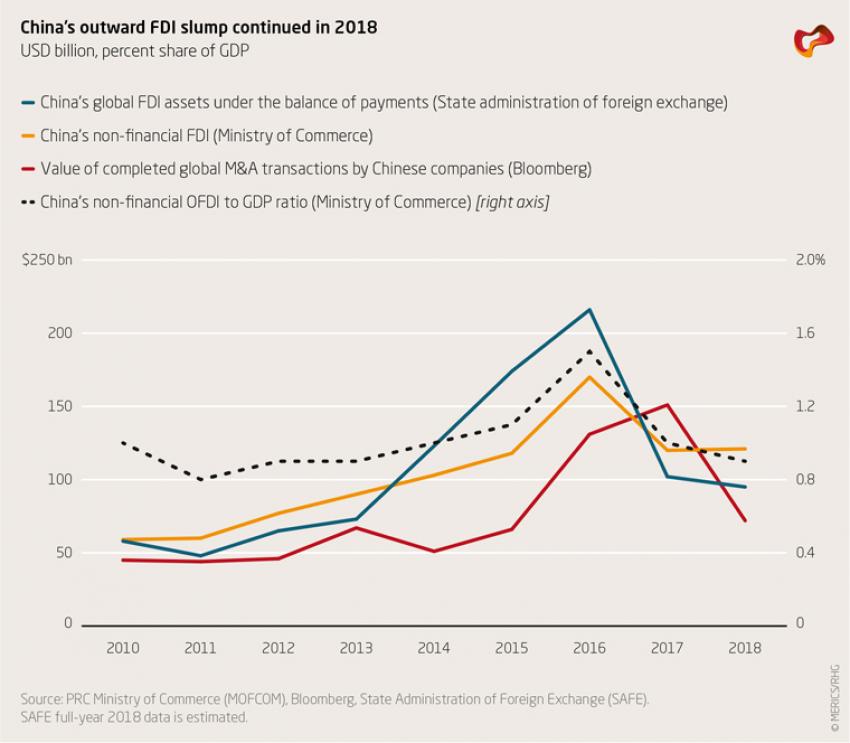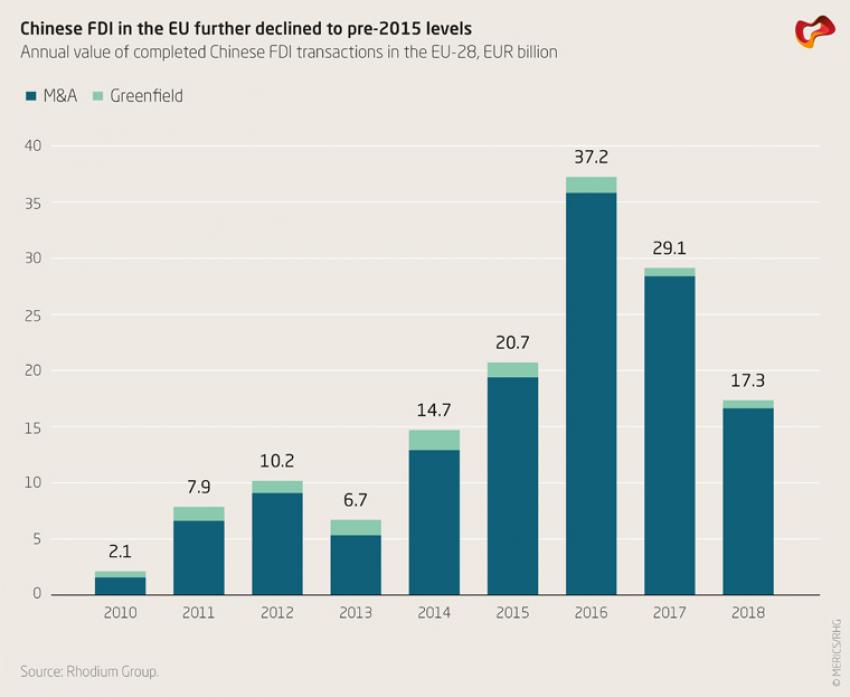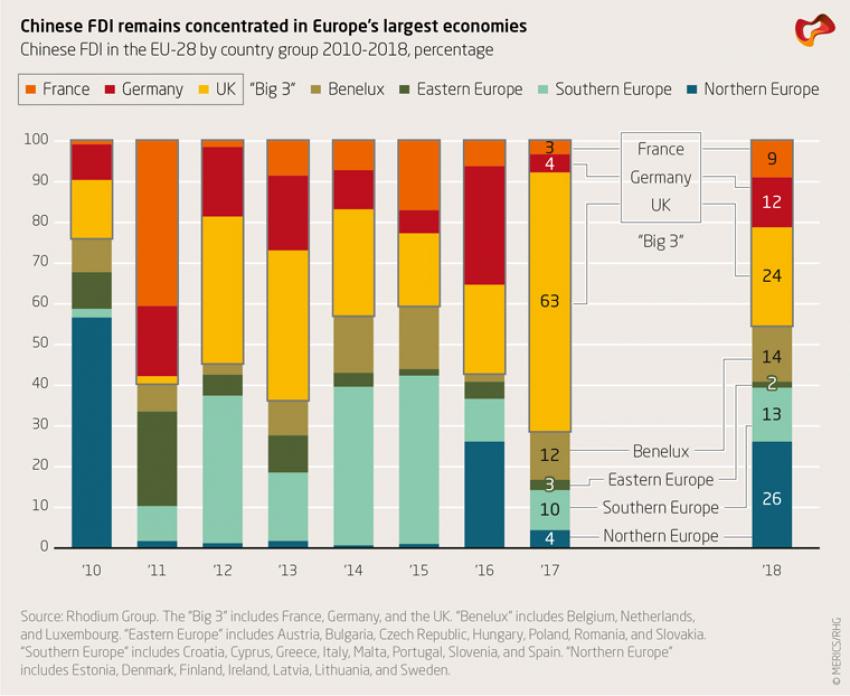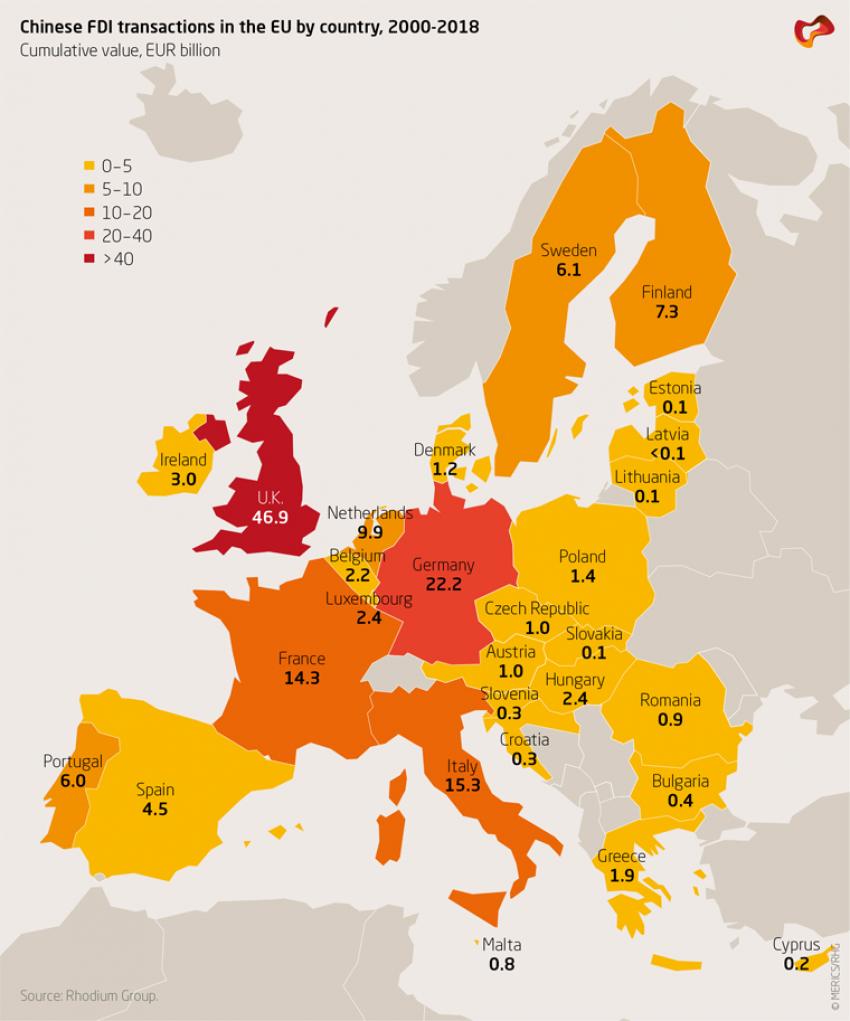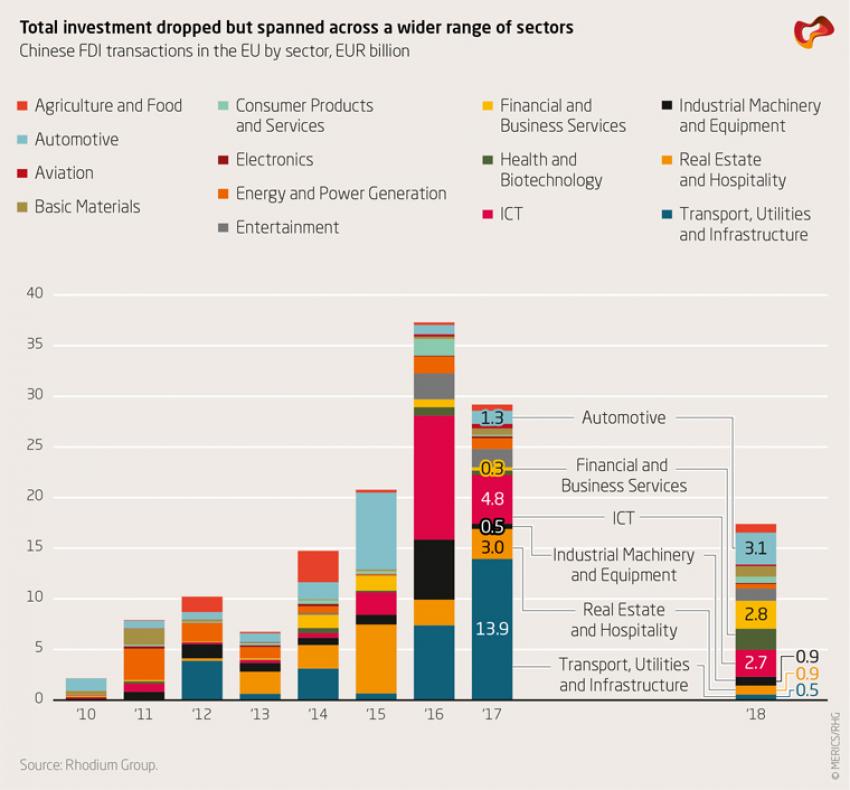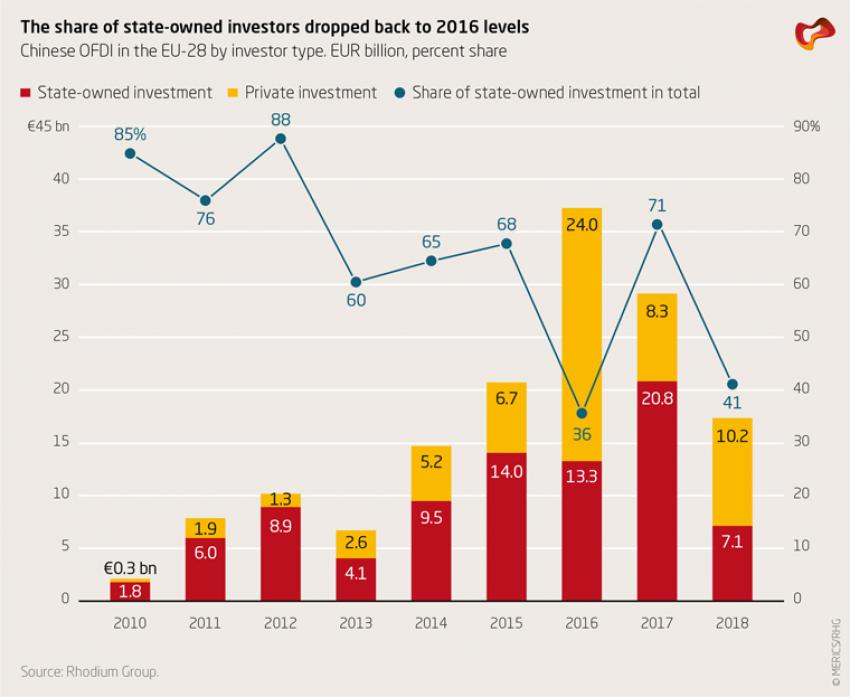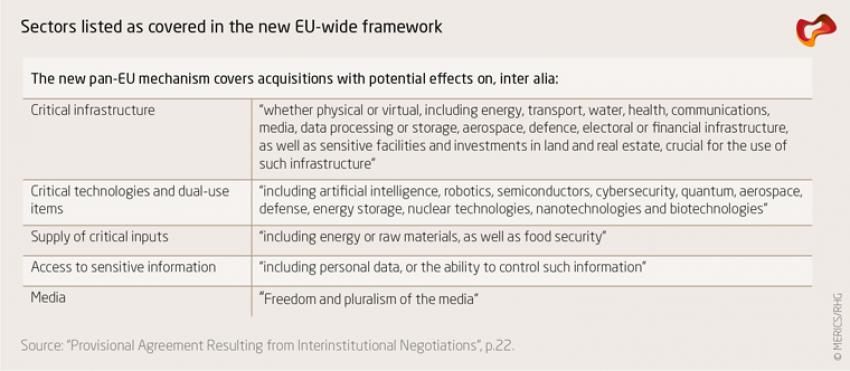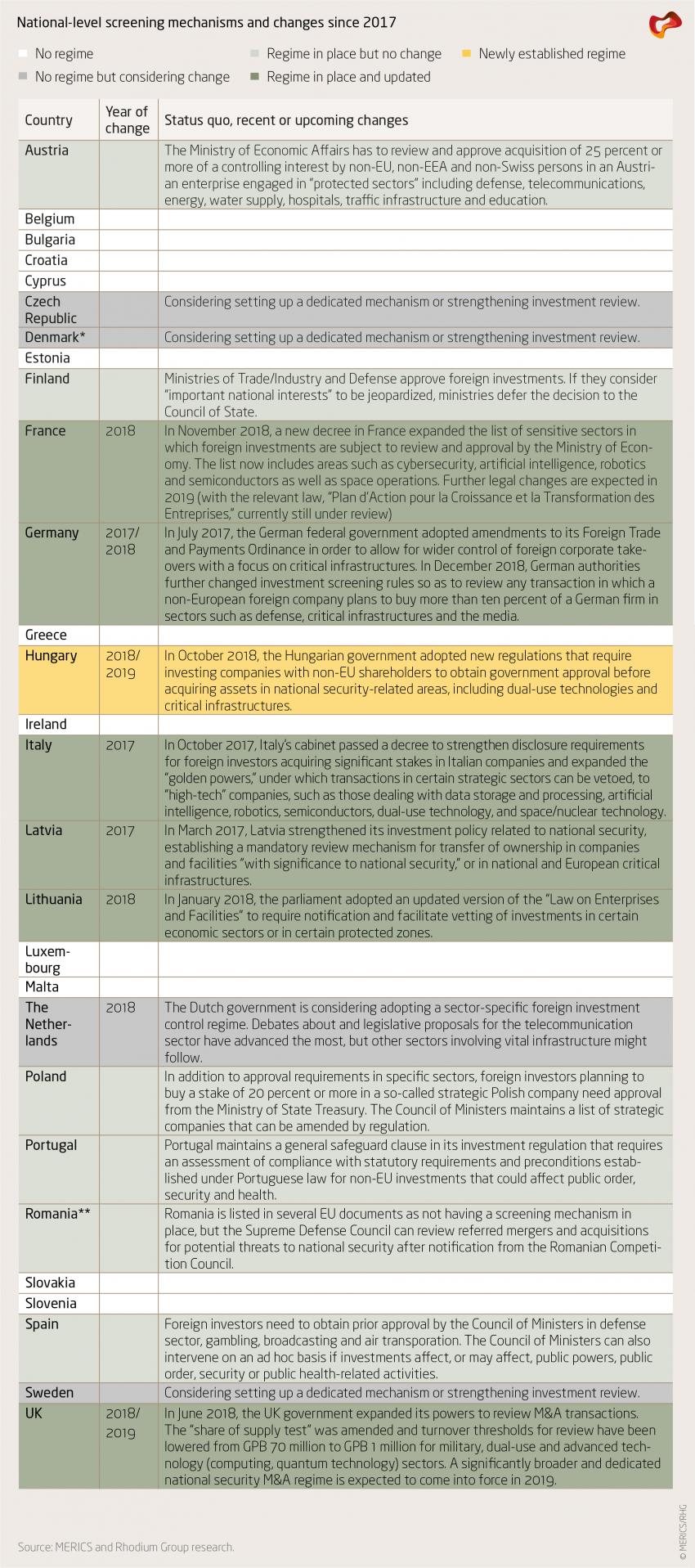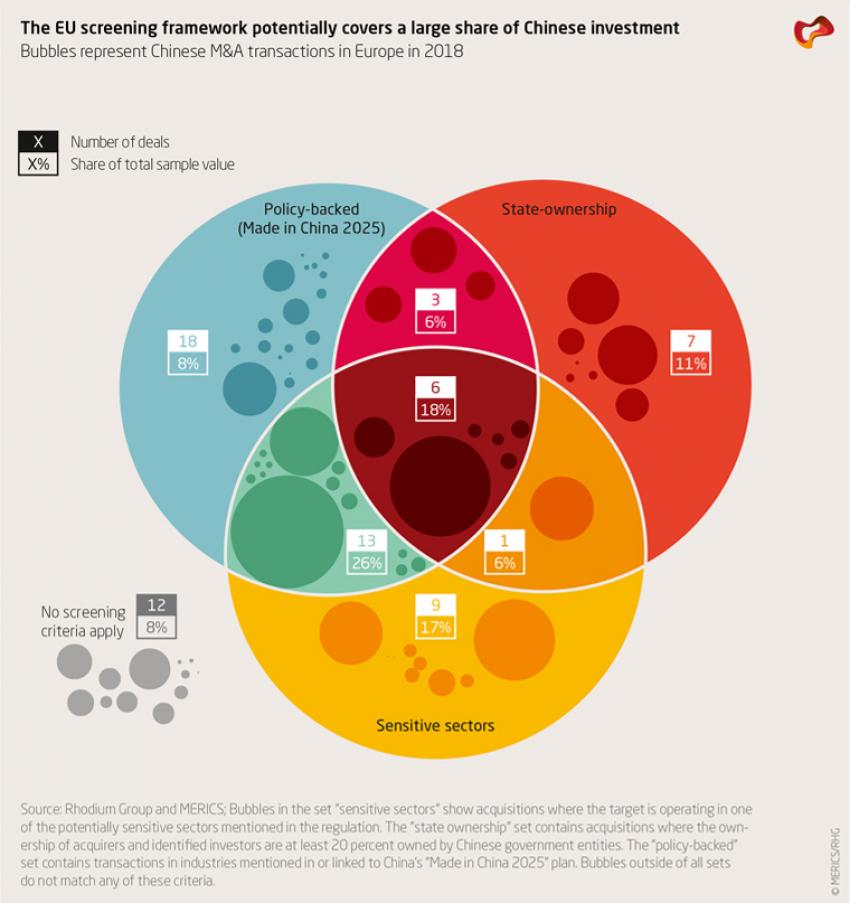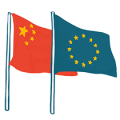

Chinese FDI in Europe: 2018 trends and impact of new screening policies
A report by Rhodium Group (RHG) and the Mercator Institute for China Studies (MERICS)
Executive summary
- Chinese foreign direct investment (FDI) in the European Union (EU) continued to decline in 2018. Chinese firms completed FDI transactions worth EUR 17.3 billion, which represents a decline of 40 percent from 2017 levels and over 50 percent from the 2016 peak of EUR 37 billion. This decline is very much in line with a further drop in China’s global outbound FDI, a trend that can be attributed to continued capital controls and tightening of liquidity in China as well as growing regulatory scrutiny in host economies.
- The “Big Three” EU economies received the lion’s share of investment. The United Kingdom (UK) (EUR 4.2 billion), Germany (EUR 2.1 billion) and France (EUR 1.6 billion) continue to receive the most attention, but their share in total Chinese FDI declined from 71 percent in 2017 to 45 percent in 2018. Two newcomers made it to the top five list (Sweden and Luxembourg), propping up the relative shares of Northern Europe and Belgium, the Netherlands and Luxembourg (Benelux) in total investment.
- Chinese investment was spread more evenly across a greater variety of sectors. With fewer mega deals Chinese capital was spread more evenly across sectors compared to 2016 and 2017. Investment declined in transport, utilities and infrastructure, and real estate. The biggest increases were recorded in financial services, health and biotech, consumer products and services, and automotive.
- EU member states are modernizing FDI screening regimes, which has raised the bar for Chinese takeovers. Several European governments have updated or established their FDI screening regimes in 2017 and 2018, and several more are in the process of doing so. This strengthening of review mechanisms has already impacted Chinese investment patterns in 2018, including the first ever instance of a blocked Chinese acquisition in Europe and several delayed transactions.
- A new EU-level screening framework will further catalyse the convergence of FDI review rules. The new regulation – a historic step in terms of breadth and speed of adoption – proposes guidelines for information exchange, coordination and empowerment for national screening. Many of its provisions remain on the liberal end of the spectrum in comparison with regulations in the United States (US) and other advanced economies. Yet the framework is more ambitious than anticipated and creates incentives for member states to put in place robust FDI monitoring mechanisms.
- The new EU investment screening framework could particularly impact Chinese investors. The EU regulation encourages member states to specifically review statesupported investments in sensitive technologies and critical infrastructure. These criteria could cover a large share of Chinese Merger & Acquisitions (M&A) activities in Europe. We estimate that 82 percent of Chinese M&A transactions in Europe in 2018 would fall under at least one of those criteria.
- Broader scrutiny of Chinese commercial presence in Europe will impact Chinese investors. More complex regulations for inbound investments are probably only the first step in a broader overhaul of Europe’s policy toward trade and investment with China. Current debates indicate that some European leaders would like/are considering reforms in other areas as well, including export controls for dual use and critical technologies, data security and privacy rules, procurement rules and competition policy. European convergence with efforts in other Organisation for Economic Co-operation and Development (OECD) economies would pose additional challenges for Chinese investors in Europe.
Introduction
The story of China’s global outward foreign direct investment (OFDI) has entered a new chapter. Following a decade of rapid growth, China’s global investment declined sharply in 2017, after Beijing re-imposed administrative controls to tame “irrational” capital outflows.
In 2018, China’s global investment fell further in most regions of the world, illustrating the fact that 2017 was not a temporary outlier. Official Chinese statistics show similar levels of outbound investment in 2018 and 2017, but other data sets point to a further decline of outbound investment of up to 50 percent (Figure 1). Moreover, Chinese companies sold tens of billions of dollars of overseas assets last year, reducing their international footprint.
The main reasons for this continued slump are still to be found at home: In 2018, Beijing maintained its tight grip on outbound capital flows; it pressured highly leveraged firms to sell off overseas assets; and it reduced liquidity in the financial system amidst a broader clean-up of the financial sector, thus drying out financing channels for overseas investments.
Another reason for lower levels of Chinese outbound investment is growing political and regulatory backlash against Chinese capital around the globe. Emerging economies are re-evaluating the benefits of Chinese initiatives such as the Belt and Road and related capital flows. In advanced economies, long-standing national security concerns and growing doubts about the compatibility of China’s economic system with modern market economies have produced higher regulatory hurdles and growing popular backlash against Chinese investment, from Washington to Canberra to Berlin.
This shift in attitudes has been remarkably rapid in Europe. Throughout 2017 and 2018, numerous European governments – including the “Big Three” recipients of Chinese capital, Germany, France and the United Kingdom (UK) – have proposed or passed new legislation that increases the scrutiny of foreign mergers and acquisitions for potential national security risks. Authorities also blocked or prevented several Chinese acquisitions that would have given investors access to critical technologies, sensitive information, or influence over critical infrastructure. In November 2018, responding to the same concerns, the European Union (EU) agreed to adopt a new framework for guiding foreign investment screening at the EU level, a move that is likely to encourage EU member states to further overhaul their national screening regimes and increase FDI-related coordination with the European Commission and fellow member states.
This report takes stock of the latest Chinese investment patterns and puts those trends in context with ongoing policy changes in Europe. We first describe Chinese FDI trends in the EU-28 in 2018 by sector, geography, and ownership. Then we discuss the latest policy shifts, both at the EU and member state level, reflecting on how these could affect future China-EU investment patterns. Finally, we analyze broader attitude and policy changes, which will likely have an impact on the operational environment for Chinese companies in the European Union.
1. Chinese investment in the EU: 2018 trends
The level and patterns of Chinese investment in Europe have shifted dramatically in 2017 compared to previous years and these changes have further deepened in 2018.1
1.1 Chinese FDI dropped for the second year in a row
After a sharp decline in 2017, Chinese FDI in the EU-28 dropped again in 2018. The combined value of completed FDI transactions fell to EUR 17.3 billion in 2018, down 40 percent from 2017 levels (EUR 29.1 billion) (Figure 2). This represents the lowest investment level since 2014 and a drop of over 50 percent from the peak of EUR 37 billion in 2016. The split between greenfield investments and acquisitions remained similar to previous years, with less than five percent of total investment attributable to greenfield projects.
There are two important caveats to this top-line figure. First, the amount recorded for 2018 would be significantly higher if we included acquisitions resulting in stakes below ten percent. These transactions are not included in our data set since they fall under the ten-percent threshold that is traditionally required to qualify as FDI. However, we saw several acquisitions last year that resulted in stakes right below that threshold – including Geely’s EUR 7.3 billion acquisition of a 9.7 percent stake in Daimler in February 2018.
Second, our dataset does not account for divestments. Yet in 2018, for the first time, Chinese investors sold European assets on a significant scale. We estimate that Chinese firms divested at least EUR 4 billion worth of assets in the EU, driven by conglomerate HNA’s sales of stakes in Avolon, Deutsche Bank, and TIP Trailer Services, as well as Wanda’s sale of its interest in the One Nine Elms development, and Nanjing Xinjiekou’s sale of its stake in House of Fraser.
1.2 Investment remained focused on the biggest EU economies, but northern Europe and the Benelux caught up
In 2018, the distribution of Chinese investment in the EU broadly followed the patterns of previous years (Figure 3). The “Big Three” economies (UK, Germany, France) continued to receive the most capital, but their share in total investment declined from 71 percent in 2017 to 45 percent in 2018. The UK was the top recipient again, with EUR 4.2 billion of completed transactions (driven by Chinese consortium Strategic IDC’s investment in Global Switch and Huadong Medicine’s acquisition of Sinclair Pharma). Germany came third, totaling EUR 2.1 billion of investment (including Kerui Tiancheng’s takeover of Biotest, and Ningbo Jifeng’s acquisition of Grammer), and France fifth, with about EUR 1.6 billion in Chinese investment (including Beijing Sanyuan Foods’ acquisition of St Hubert, and CITIC’s acquisition of Axilone Plastique).
Two newcomers made it into the top five list, propping up the relative shares of Northern Europe and Benelux in total investment. Sweden was Chinese investors’ second preferred destination in 2018 with EUR 3.4 billion of total investment (driven by Zhejiang Geely’s EUR 3 billion investment in Volvo AB). And Luxembourg came in fourth, at EUR 1.6 billion (mostly attributable to Legend’s acquisition of Banque Internationale à Luxembourg).
Southern Europe accounted for about 13 percent of Chinese FDI last year, still well below the boom years of 2012 to 2015. Most of it was attributable to a few large M&A transactions: Orient Securities’ acquisition of a stake in Imagina Media (Spain), SARI’s acquisition of NMS Group ( Italy), and a Chinese investor group’s acquisition of Esaote (Italy). One deal that would have boosted Southern Europe’s position in the ranking is China Three Gorges’ EUR 9 billion acquisition of Portuguese utility Energias de Portugal SA (EDP), but regulatory complications slowed down the process; it is currently unclear whether the deal will be completed.
Finally, Chinese investment in Eastern European member states declined last year. The region is still failing to attract any significant M&A activity from Chinese investors, and accounts for only 1.5 percent of all Chinese investment in the EU. However, last year did show some pockets of growth in terms of greenfield FDI in particular in manufacturing, Research and Development (R&D), and renewable energy projects. Examples include Unisun’s solar farm in Hungary, Great Wall
Motor’s R&D center in Austria, and Nuctech’s plant in Poland.
1.3 The industry mix became more diverse and investments hit records in several sectors
Compared to previous years, the industry mix of Chinese investment in Europe was remarkably diverse in 2018 (Figure 5). With only a few exceptions, China’s new outbound investment regime effectively curbed mega acquisitions seen in previous years (such as Logicor, Pirelli, Supercell), leading to a more equal and balanced spread of capital across sectors. In 2018, no single industry accounted for more than 20 percent of total investment.
Among the top sectors, those that saw particular strong growth last year include automotive (EUR 3.1 billion, driven by Geely’s investment in Volvo AB), financial and business services (EUR 2.8 billion, driven by Legend’s EUR 1.5 billion acquisition of Banque Internationale à Luxembourg, and Geely’s EUR 1.0 billion acquisition of Saxo Bank), and health and biotech (EUR 2 billlion, driven by Kerui Tiancheng’s acquisition of Biotest).
In contrast, investment in transport, utilities and infrastructure dropped 96 percent from EUR 13.9 billion in 2017 to EUR 0.5 billion in 2018 (most of last year’s figure was accounted by one investment, CIC’s acquisition of Logicor). Real estate also continued to drop, to EUR 0.9 billion, from a peak of EUR 6.8 billion in 2015.
1.4 Investment by state-owned companies dropped to a 5-year low
The share of state-owned companies in total Chinese investment in Europe has declined from 80 to 90 percent between 2010 and 2012 to an average of around 50 to 60 percent in the past five years (Figure 6). After reaching its lowest level in more than a decade in 2016 (at 36 percent), the share of State-owned enterprises (SOEs), however, increased again in 2017, to 71 percent, as capital controls hit private companies and only allowed mega deals by state investors (such as CIC’s EUR 12.3 billion acquisition of Logicor).
In 2018, the weight of SOEs declined again to 41 percent of aggregate investment, the second lowest level on record. This was a result both of declining SOE investment, as well as a slight recovery of private investment activity (though deal sizes remained well below those seen in 2015 and 2016).
2. The EU’s new investment screening landscape
The rapid rise of Chinese outbound investment in the past decade has triggered an overhaul of investment screening regimes in many advanced economies including Australia, Canada, Japan, and recently the United States. Europe long lagged behind but played catch-up in the past two years. Many of the big European economies have overhauled their screening regimes or are in the process of doing so. These changes have contributed to the first Chinese transaction being effectively blocked in Europe (Leifeld) and others being derailed by indirect intervention (50 Hertz) or delayed by regulatory requests (EDP). Looking ahead, this process will likely be intensified by new EU-wide efforts to better coordinate investment screening. In a time span of just 18 months, the European Union has engineered the setup of an EU-wide investment screening framework, which could particularly impact Chinese investors.
2.1 The new framework improves coordination and cooperation within the EU
In September 2017, European Commission President Jean-Claude Juncker kicked off work on a EUwide instrument for FDI review, with the release of the Commission’s proposal for a pan-EU framework.2 Over the next nine months, the EU Council and the European Parliament drafted their own position papers in preparation for trilateral negotiations which started over the summer. These negotiations ended in November 2018 with a tripartite agreement on a draft regulation.3 The proposed text has since been adopted by member states representatives on November 30 and the Parliament’s Committee on International Trade (INTA) on December 10. The European Parliament plenary approved the legislation on February 14, with the final endorsement of the EU Council at ministerial level expected on March 5. The regulation will then be implemented over the following 18 months.
In global comparison, the new EU investment screening framework is much less invasive and comprehensive than most other Organisation for Economic Co operation and Development (OECD) screening frameworks currently in place. Rather than representing a robust EU-wide investment screening tool, the new instrument is still a loose “coordination and cooperation” framework (as noted in the draft regulation), through which EU countries can share information with, and require information from, other member states on specific foreign investments that potentially impact on their national security and public order.
The new framework allows the European Commission to issue opinions on transactions that concern multiple member states or target a project or program affecting the interests of the EU as a whole. Those opinions are not binding, though in cases affecting the EU as a whole member states would be required to justify their decision not to follow the Commission’s opinion. Moreover, the new EU framework still restricts screening to “security and public order” concerns and does not extend reviews to include economic criteria or a “net benefit test” (which some other OECD countries do). Finally, the framework only covers acquisitions and does not apply to greenfield investment or to venture capital and other portfolio investments.
Though it does not create a strong centralized EU screening system, the new framework is a historic milestone that will have a profound impact on European treatment of inbound acquisitions. First, the factors to consider when screening for risks to security and public order are very broad and include a wide range of sectors from energy, transport, and artificial intelligence to finance, water supply, health, and the media (Table 1). The list of sectors is only indicative, not exhaustive, hence allowing for more sectors to be added in the future, should they be considered to have the potential to affect member states’ “security or public order.”
Second, the proposed regulation requires member states that already have a screening mechanism to implement measures allowing them to “identify and prevent” cases of “circumvention” of national screening mechanisms and decisions. In short, member states with a screening mechanism are asked to look beyond investments directly flowing from non-EU countries and to also look into intra-EU investments involving non-EU ultimate owners. Under this provision, member states will for example be strongly encouraged to scrutinize intra-EU investments by Chinese-owned companies such as Logicor, Volvo or Pirelli. Member states are also encouraged to consider risks emerging from changes to the ownership structure or key characteristics of a foreign investor.
Third, the regulation includes several provisions intended to incentivize a gradual convergence of national screening regimes. For example, it requires each member state to submit an annual report summarizing inward FDI activity. It also requires member states to establish a national contact point for FDI matters. These monitoring requirements are likely to create incentives for member states without an investment screening tool to at least create dedicated capacities to monitor and analyze foreign acquisitions. In practice, the discussions during the genesis of the new EU investment screening framework have already catalyzed such convergence toward more diligent investment screening. Seven out of 28 EU member states have set up or updated their FDI screening regimes in the past two years, and three more are considering or drafting new regulations (Table 2).
Finally, the regulation encourages international cooperation among “like-minded” countries, through the sharing of experience, best practices, and information on foreign direct investment (a trend already visible among certain OECD governments).
2.2 Specific implications for Chinese investors
While the EU will remain on the liberal end of the spectrum, the new FDI screening framework will generally increase scrutiny of foreign acquisitions – and could affect Chinese investors in particular. While non-discrimination toward the nationality of an investor is a core principle of the EU and of the new regulation, some of its provisions overlap with core characteristics of Chinese investment in Europe to date.
First, many of the areas and sectors earmarked for special scrutiny under the new EU rules are preferred sectors for Chinese investors in Europe. China’s FDI profile in the EU-28 is very diverse, but a large share of investments is targeted at European technology and innovation assets. Chinese investors also spent more than EUR 29 billion on EU infrastructure and logistics between 2012 and 2017.
Second, the new rules call for heightened scrutiny of investments by directly or indirectly state-controlled entities (including through significant state-backed funding, rather than ownership). Based on historical patterns, about 60 percent of Chinese FDI in the EU since 2000 originated from state-owned or sovereign entities in China.
Finally, the regulation encourages member states to review investments that form part of “stateled outward projects or programs.” Given the pervasiveness of industrial policy in China and the dominance of state-owned banks in the country’s financial system, this vague formulation could open the door for member states to review a large swath of Chinese investment in the EU.
To illustrate the potential impact of the regulation on Chinese FDI into the EU-28, we built a sample of major Chinese acquisitions in the EU in 2018 (greenfield investments are not covered by the new regulation) and reviewed whether they match the three dimensions mentioned above.4 First, we determined whether the acquisition target is operating in one of the potentially sensitive sectors mentioned in the regulation (“sensitive sectors”). Second, we reviewed the ownership of acquirers and identified investors that are at least 20 percent owned by Chinese government entities (“state ownership”). Third, we identified transactions in industries mentioned in or linked to China’s “Made in China 2025” plan (“policy-backed”).5
While only a rough approximation, this exercise illustrates that the guidance in the new EU investment screening framework theoretically covers a very high share of inbound Chinese M&A transactions. We find that 83 percent of the number of transactions in our 2018 sample meet at least one of those criteria (Figure 7): 46 percent of transactions fall in one of the sectors marked as sensitive (accounting for 71 percent of total sample value); 25 percent of the transactions were done by state-owned entities (representing 41 percent of total sample value); and 58 percent (in both number and value terms) fall into a sector linked to the “Made in China 2025” program. More than one third of transactions in our sample (60 percent of the sample value) meet at least two of these criteria, and one in ten (and 18 percent of the sample value) meet all three. Importantly, these figures would likely have been even higher in previous years since the role of SOEs was more pronounced and Information and Communication Technology (ICT) and infrastructure played an even greater role in the industry mix.
Of course, not all these transactions would necessarily be reviewed. The implementation of the EU framework will depend on the EU’s 27 national governments (assuming the UK will leave the EU) all of whom will retain significant leeway to interpret these regulations strictly or liberally, and to define the sectors they consider as sensitive. Moreover, investment reviews do not necessarily mean negative outcomes, and EU governments will retain the right to authorize transactions even if they fall into one, two, or all of the categories, if no risk to national security or public order is found.
However, it is likely that national governments will consider EU guidance when they monitor and review investments under existing regimes, especially since the European Commission and other member states can request information on transactions in these areas. It is also likely that the EU framework will influence countries that are in the process of setting up new regimes or updating existing ones.
3. Outlook: Greater scrutiny of Chinese commercial presence in the EU
Despite these regulatory changes, the near-term outlook for Chinese investment in the EU is relatively strong. At the beginning of 2019, Chinese investors had more than EUR 15 billion worth of proposed transactions pending (including Anta’s proposed acquisition of Amer Sports for EUR 4 billion), which shows that the EU remains an attractive investment destination. Chinese investment in Europe is likely to get a further boost from the recent expansion of the US investment screening regime and the broader deterioration of US-China relations, which will cause some investors to divert capital from North America to the European continent. The modernization of EU investment screening regimes will shape the longer term outlook as member states implement reforms over the course of the next 18 months.
Another important variable is to what extent the EU and its memberstates will follow other advanced market economies in taking a more nuanced and defensive stance towards economic engagement with China. European debates about risks from economic engagement with China now extend far beyond FDI reviews. EU institutions, national governments, and businesses are publicly re-thinking past approaches and calling for a “less naïve” stance toward economic and political engagement with China.6 Though the debate is still relatively young in Europe, it is fast-moving and its impact is already visible in many areas including:
- Calls for a new approach to EU competition policy to respond to Chinese state-supported conglomerates (with criticism currently focused on the blocked Siemens/Alstom merger)
- A more careful interpretation of Europe’s principled openness to Chinese bidders in public tenders (such as in infrastructure projects in Croatia and Poland)
- Greater scrutiny of data security compliance of Chinese service providers (for instance bikesharing company Mobike being under scrutiny for a lack of user data protection)
- Joint warnings or even sanctions in response to cyberattacks and other espionage efforts (with the UK leading the effort to hold China accountable for cyberattacks by the Advanced Persistent Threat (APT) 10 group)
- Enforcement of compliance with money laundering and other financial regulations (see recent cases against major state-owned banks in Italy and Spain)
- A backlash against the supply of Chinese telecommunications equipment and services to European markets (with Huawei’s potential role in European 5G networks being the focal point of attention)
These changes in attitudes and growing scrutiny across a range of regulatory and policy areas could severely affect China’s investment footprint in Europe in the coming years. The controversy about Huawei’s role in Europe’s 5G infrastructure illustrates these developments. Huawei has invested heavily in European research and development, 5G trials, and other partnerships to become a major – if not the leading – telecommunications equipment supplier in Europe. If European governments proceed to limit Huawei’s opportunities in servicing European telecommunication markets – or ban Huawei as a provider entirely – it is highly likely that Huawei would shrink its investment in R&D, real estate, and other commercial partnerships across Europe (as it has done in the United States).
Despite the risks of losing investment, the current political realities indicate that the overhaul of investment screening frameworks is probably only the first step in a broader overhaul of the EU’s stance and policy tools in response to growing Chinese economic activities in Europe. The Union and its member states are playing catch up with other advanced economies that have already implemented similar policies in response to concerns about the nature and direction of China’s economic and political system. If other OECD economies serve as a guide, the most likely areas for additional policy action are export controls for dual use and critical technologies, data security and privacy rules, procurement rules, and competition policy.
Instead of emulating the policy of the US and other OECD nations, Europe will have to identify its own solutions to challenges in those policy areas, so they match Europe’s unique interests, values and political realities. The pace and efficiency with which the new EU FDI screening framework was created and adopted shows that collaboration between member states and Brussels can work and yield robust outcomes.
The European election cycle of 2019 could potentially disrupt efforts toward a more streamlined European position on trade and investment with China, but recent efforts to institutionalize bureaucratic coordination in Brussels, similar developments in many European capitals, and coordination with other OECD governments have increased the chances of greater strategic coherence of European external economic policy toward China even under new political leadership.
- Endnotes
-
1 | We rely on a transactional data set that is compiled by tracking completed FDI transactions by mainland Chinese companies in the 28 countries of the European Union. For a detailed description of the data methodology, please refer to the appendix in https://www.merics.org/sites/default/files/2017-09/COFDI_2015_EN.pdf.
2 | European Commission - Press release, “State of the Union 2017 - Trade Package: European Commission proposes framework for screening of foreign direct investments”, Brussels, 14 September 2017 http://europa.eu/rapid/press-release_IP-17-3183_en.htm.
3 | “Provisional Agreement Resulting from Interinstitutional Negotiations” http://www.europarl.europa.eu/meetdocs/2014_2019/plmrep/COMMITTEES/INTA/AG/2018/12-10/1171525EN.pdf.
4 | We only included acquisitions with a value of at least EUR 1 million.
5 | This includes deals in semiconductors, IT equipment, software and IT services, industrial machinery and equipment, aerospace equipment and components, other transportation equipment, automotive equipment and components, renewable energy equipment, farming logging and animal husbandry, plastic rubber and other materials, pharmaceuticals and biotechnology, and medical devices.
6 | Two examples are the 2016 “Elements for a new EU strategy on China”, which highlighted the need to “put [EU’s] own interests at the forefront in the new relationship” (p.2), as well as a more recent BDI policy paper on China as a “Partner and Systemic Competitor”.

